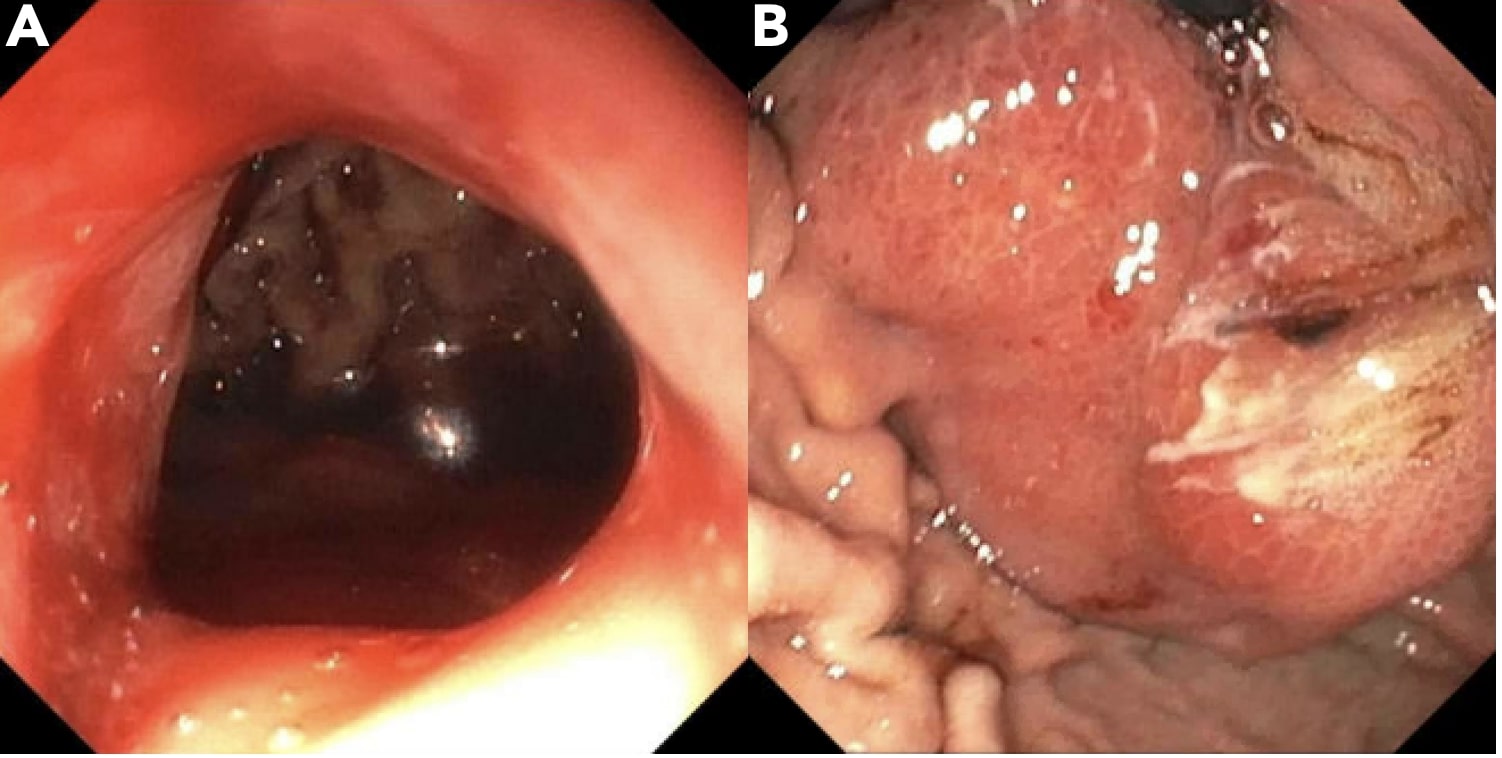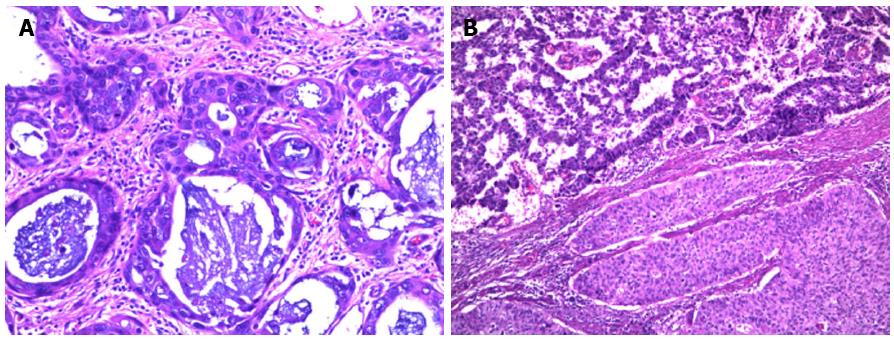Tuesday Poster Session
Category: Esophagus
P5045 - Adenosquamous Carcinoma of the GEJ in a Young Male
Tuesday, October 28, 2025
10:30 AM - 4:00 PM PDT
Location: Exhibit Hall

Rachael Hagen, DO (she/her/hers)
University of Connecticut Health
Farmington, CT
Presenting Author(s)
Award: ACG Presidential Poster Award
Rachael Hagen, DO1, Bianca Thakkar, DO1, Norbert Promagan, MD2, Minh Thu T.. Nguyen, MD3
1University of Connecticut Health, Farmington, CT; 2Hartford Hospital, Hartford, CT; 3University of Connecticut, Farmington, CT
Introduction: Esophageal cancer is classified into two types: adenocarcinoma (AC) and squamous cell carcinoma (SCC). Esophageal adenosquamous carcinoma (EASC) is a rare, aggressive subtype comprising both AC and SCC components, accounting for approximately 0.76% of esophageal cancers. EASC carries a poorer prognosis than either AC or SCC alone. We report a case of EASC in a young male with no traditional risk factors, found to have a BRCA2 mutation.
Case Description/
Methods: A 26-year-old male with no medical history presented with progressive dysphagia to solid foods and a 50-pound weight loss over four months. Laboratory findings revealed iron deficiency anemia (hemoglobin 8.4 g/dL, MCV 76 fL, ferritin 12 ng/mL, iron saturation 13%). Esophagogastroduodenoscopy (EGD) showed esophageal stenosis requiring dilation to 10 mm and a large, irregular gastroesophageal junction (GEJ) lesion (Fig. 1A-B). Pathology revealed erosive carditis and Helicobacter pylori but was negative for malignancy.
Abdominal computed tomography (CT) identified a large GEJ mass with liver and lung lesions. Endoscopic ultrasound (EUS) revealed esophageal narrowing, for which stent placement and aspiration were performed. Pathology confirmed invasive moderately differentiated ASC, which was also identified on liver biopsy (Fig 2). The patient denied alcohol use, nicotine use, or family history of malignancy. Genetic testing revealed a BRCA2 gene mutation.
He underwent chemoradiation to the esophagus and later required biliary sphincterotomy and stent replacement. Despite aggressive treatment, he developed liver failure and uncontrolled pain due to cancer progression. He and his family ultimately opted for a comfort-focused approach.
Discussion: This case describes one of the youngest patients with EASC reported in the literature, where the mean age at diagnosis is approximately 65.1 years. His young age is especially notable given the absence of traditional risk factors. Known risk factors for EASC include Barrett’s esophagus, which also increases risk of AC, while smoking and alcohol use are associated with a higher risk of SCC. Interestingly, H. pylori has been suggested to decrease the risk of AC. Notably, the patient was found to carry a pathogenic BRCA2 variant, which has been linked to an increased risk of esophageal cancers, although further research is needed to clarify its relationship with EASC. This case highlights the importance of recognizing this rare cancer, as its poor prognosis requires prompt diagnosis and treatment.

Figure: Figure 1. (A) Esophagogastroduodenoscopy (EGD) showing esophageal stenosis in the lower third of the esophagus, requiring dilation. (B) A large, irregular mass was visualized where the gastric cardia meets the GEJ with a reticular pattern of vessels.

Figure: Figure 2. Example of esophageal adenosquamous carcinoma on pathology. (A) The glandular adenocarcinoma cells and keratinized squamous carcinoma cells may be intermixed (Hematoxylin and eosin staining, 200X). (B) The adenocarcinoma cells and squamous carcinoma cells may also be clearly delineated (Hematoxylin and eosin staining, 100X).
Reference: Chen SB, Weng HR, Wang G, Yang JS, Yang WP, Liu DT, Chen YP, Zhang H. Primary adenosquamous carcinoma of the esophagus. World J Gastroenterol 2013; 19(45): 8382-8390 [PMID: 24363531 DOI: 10.3748/wjg.v19.i45.8382]
Disclosures:
Rachael Hagen indicated no relevant financial relationships.
Bianca Thakkar indicated no relevant financial relationships.
Norbert Promagan indicated no relevant financial relationships.
Minh Thu Nguyen indicated no relevant financial relationships.
Rachael Hagen, DO1, Bianca Thakkar, DO1, Norbert Promagan, MD2, Minh Thu T.. Nguyen, MD3. P5045 - Adenosquamous Carcinoma of the GEJ in a Young Male, ACG 2025 Annual Scientific Meeting Abstracts. Phoenix, AZ: American College of Gastroenterology.
Rachael Hagen, DO1, Bianca Thakkar, DO1, Norbert Promagan, MD2, Minh Thu T.. Nguyen, MD3
1University of Connecticut Health, Farmington, CT; 2Hartford Hospital, Hartford, CT; 3University of Connecticut, Farmington, CT
Introduction: Esophageal cancer is classified into two types: adenocarcinoma (AC) and squamous cell carcinoma (SCC). Esophageal adenosquamous carcinoma (EASC) is a rare, aggressive subtype comprising both AC and SCC components, accounting for approximately 0.76% of esophageal cancers. EASC carries a poorer prognosis than either AC or SCC alone. We report a case of EASC in a young male with no traditional risk factors, found to have a BRCA2 mutation.
Case Description/
Methods: A 26-year-old male with no medical history presented with progressive dysphagia to solid foods and a 50-pound weight loss over four months. Laboratory findings revealed iron deficiency anemia (hemoglobin 8.4 g/dL, MCV 76 fL, ferritin 12 ng/mL, iron saturation 13%). Esophagogastroduodenoscopy (EGD) showed esophageal stenosis requiring dilation to 10 mm and a large, irregular gastroesophageal junction (GEJ) lesion (Fig. 1A-B). Pathology revealed erosive carditis and Helicobacter pylori but was negative for malignancy.
Abdominal computed tomography (CT) identified a large GEJ mass with liver and lung lesions. Endoscopic ultrasound (EUS) revealed esophageal narrowing, for which stent placement and aspiration were performed. Pathology confirmed invasive moderately differentiated ASC, which was also identified on liver biopsy (Fig 2). The patient denied alcohol use, nicotine use, or family history of malignancy. Genetic testing revealed a BRCA2 gene mutation.
He underwent chemoradiation to the esophagus and later required biliary sphincterotomy and stent replacement. Despite aggressive treatment, he developed liver failure and uncontrolled pain due to cancer progression. He and his family ultimately opted for a comfort-focused approach.
Discussion: This case describes one of the youngest patients with EASC reported in the literature, where the mean age at diagnosis is approximately 65.1 years. His young age is especially notable given the absence of traditional risk factors. Known risk factors for EASC include Barrett’s esophagus, which also increases risk of AC, while smoking and alcohol use are associated with a higher risk of SCC. Interestingly, H. pylori has been suggested to decrease the risk of AC. Notably, the patient was found to carry a pathogenic BRCA2 variant, which has been linked to an increased risk of esophageal cancers, although further research is needed to clarify its relationship with EASC. This case highlights the importance of recognizing this rare cancer, as its poor prognosis requires prompt diagnosis and treatment.

Figure: Figure 1. (A) Esophagogastroduodenoscopy (EGD) showing esophageal stenosis in the lower third of the esophagus, requiring dilation. (B) A large, irregular mass was visualized where the gastric cardia meets the GEJ with a reticular pattern of vessels.

Figure: Figure 2. Example of esophageal adenosquamous carcinoma on pathology. (A) The glandular adenocarcinoma cells and keratinized squamous carcinoma cells may be intermixed (Hematoxylin and eosin staining, 200X). (B) The adenocarcinoma cells and squamous carcinoma cells may also be clearly delineated (Hematoxylin and eosin staining, 100X).
Reference: Chen SB, Weng HR, Wang G, Yang JS, Yang WP, Liu DT, Chen YP, Zhang H. Primary adenosquamous carcinoma of the esophagus. World J Gastroenterol 2013; 19(45): 8382-8390 [PMID: 24363531 DOI: 10.3748/wjg.v19.i45.8382]
Disclosures:
Rachael Hagen indicated no relevant financial relationships.
Bianca Thakkar indicated no relevant financial relationships.
Norbert Promagan indicated no relevant financial relationships.
Minh Thu Nguyen indicated no relevant financial relationships.
Rachael Hagen, DO1, Bianca Thakkar, DO1, Norbert Promagan, MD2, Minh Thu T.. Nguyen, MD3. P5045 - Adenosquamous Carcinoma of the GEJ in a Young Male, ACG 2025 Annual Scientific Meeting Abstracts. Phoenix, AZ: American College of Gastroenterology.

